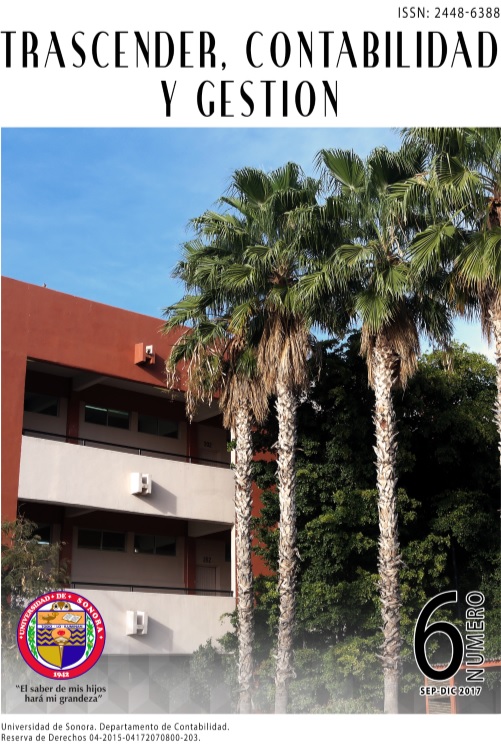The intellectual capital and its valuation, as part of the intangible assets in the financial information of the company
DOI:
https://doi.org/10.36791/tcg.v0i6.20Keywords:
Intellectual capital, Active intangible, Accounting regulationsAbstract
Currently, it has gained strength and increased its importance, currently, the value of intellectual Business, has gained; it is recognized that it must be part of the financial statements, since wealth is generated by people as well as the business itself. The problem of how to assign a value to it, is presented, so studies and business researchers have been given to the task of looking for indicators that show how people and the organizations themselves generate value by creating a series of models that are used by diverse companies especially those that are competitive and that are at the forefront in the world of business. Some models are presented in a brief way Through time they have been designing, trying to sustain the value assignment, some of them coinciding of them in the various criteria that state that They add value to companies. The current accounting regulations are analyzed, in relation to intangible assets and their treatment in regarding its valuation and reflection in the financial information The problem is how to assign value to intellectual capital in a sustained and reasonable way with the goal that from the accounting point of view is tangible and can be reflected in the financial information The work is an analytical review of the existing bibliography reaching the conclusion that There are several criteria that help to assign value to you through some manifestations and concepts that are present in individuals and in organizations but in a subjective way.Downloads
References
Brooking, Annie, Capital Intelectual, tr. Juan Carlos Guix, Paidós, Barcelona, 1997,250 pp
Edvinsson, L. y Malone M.S. (2003) El Capital Intelectual, Gestión 2000 Barcelona
Funes Cataño, Yolanda, Valuación de los activos intangibles. Caso de la UNAM Revista del Centro de Investigación. Universidad La Salle [en línea] 2010, 9 (Enero-Junio): [Fecha de consulta: 20 de abril de 2017] Disponible en:http://www.redalyc.org/articulo.oa?id=34213111003 ISSN 1405-6690
Marín González, Freddy, El capital intelectual como activo organizacional Espacio Abierto [en línea] 2001, 10 (julio-septiembre): [Fecha de consulta: 20 de abril de 2017] Disponible en:<http://www.redalyc.org/articulo.oa?id=12210304> ISSN 1315-0006
Martínez Villegas, Fabián. Activos Intangibles de la revolución industrial 4.0. Contaduría Pública (Febrero 2017)
Sánchez Díaz, Marlery, El capital intelectual y su relación con diferentes gestiones: estudio teórico-conceptual Ciencias de la Información [en línea] 2012, 43 (Septiembre-Diciembre): [Fecha de consulta: 20 de abril de 2017] Disponible en:<http://www.redalyc.org/articulo.oa?id=181424691001> ISSN 0864-4659
Valenzuela Arancibia Lisbeth, (2013) Método Skandia. Facultad de Economía y Administración de Contabilidad y Auditoría “Empresa y Sociedad del Conocimiento”
CINIF, (2016) Consejo Mexicano de Normas de Normas de Información Financiera.
Páginas de Internet
http://www.gestiondelcapitalintelectual.com/
http://redalyc.uamex.mx/redalyc/pdf/849
www.ejournal.unam.mx.-rca
http://ingenierias.uanl.mx/20pdf/20/laevaluaciondeactivos
http://www.infoviews.com.mx/Bitam/ScoreCard/
http://ascanio.blogspot.mx/2007/05/intellectual-assets-monitor-sveiby-1997.html
Downloads
Published
How to Cite
Issue
Section
License
Copyright (c) 2019 Sergio Félix Enríquez, Ana Elsa Ortiz Noriega, Fernando Calles Montijo

This work is licensed under a Creative Commons Attribution-NonCommercial-NoDerivatives 4.0 International License.
La Revista Trascender, Contabilidad y Gestión se compromete a asegurar la confidencialidad y privacidad dela información personal que se capture en éste sistema de conformidad con los lienamientos editoriales de la Universidad de Sonora
La información será utilizada únicamente para fines editoriales, académicos y de investigación, notificándose de forma directa al usuario registrado en el sistema, con el alcance que el usuario establezca al momento de su registro.


























